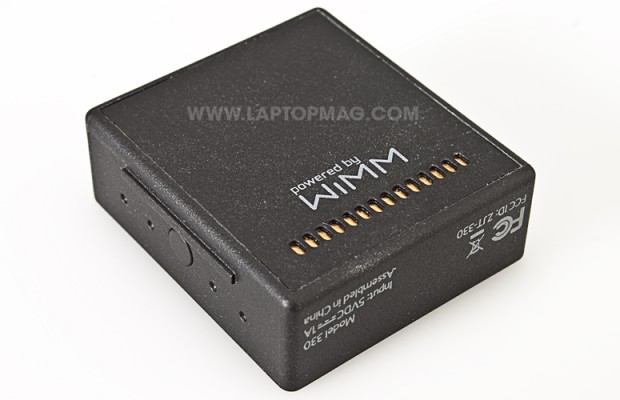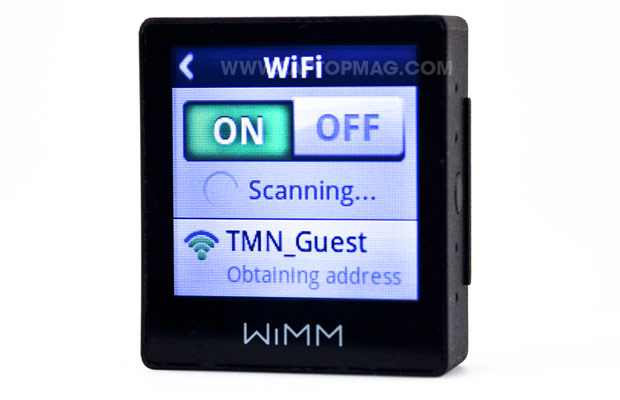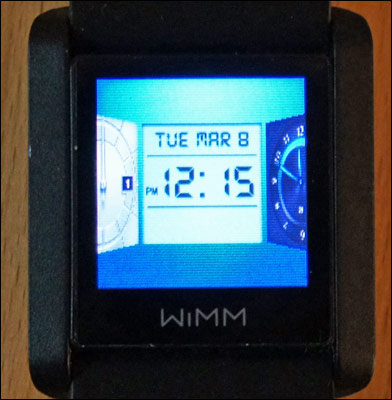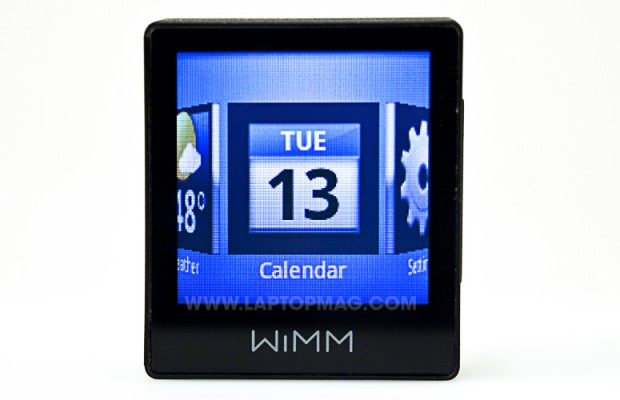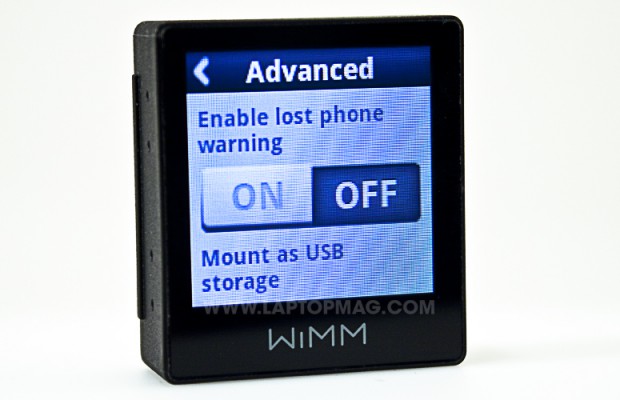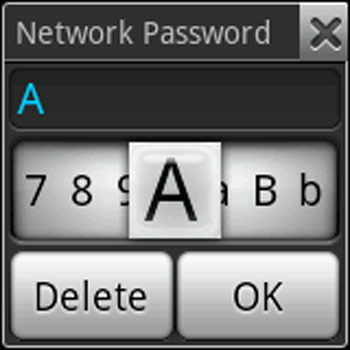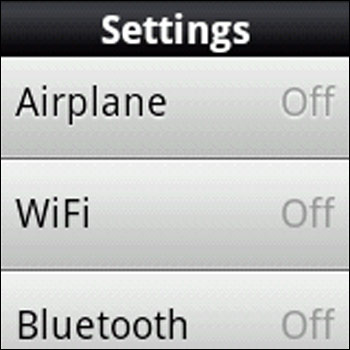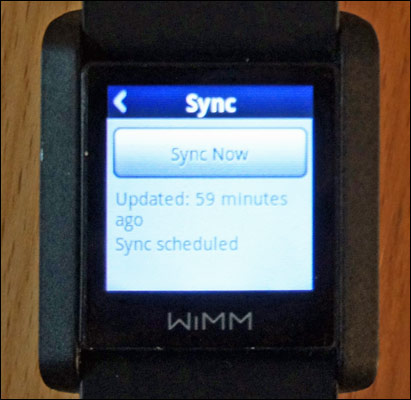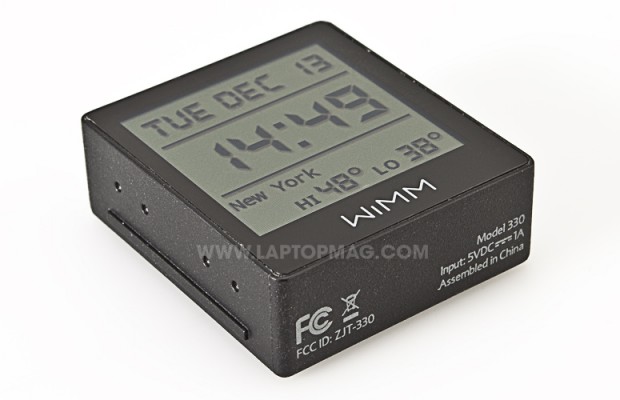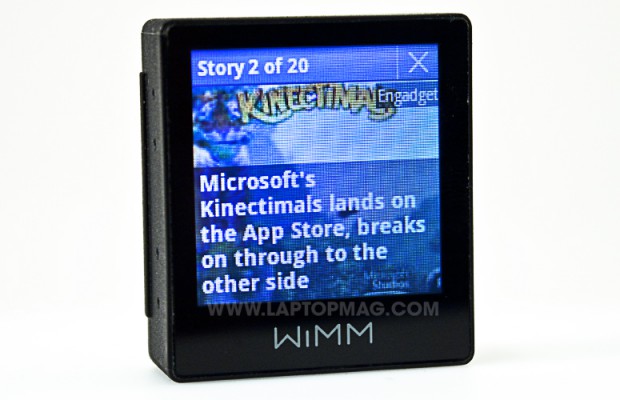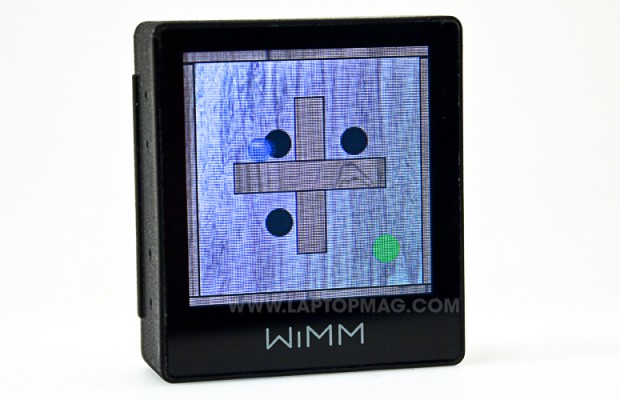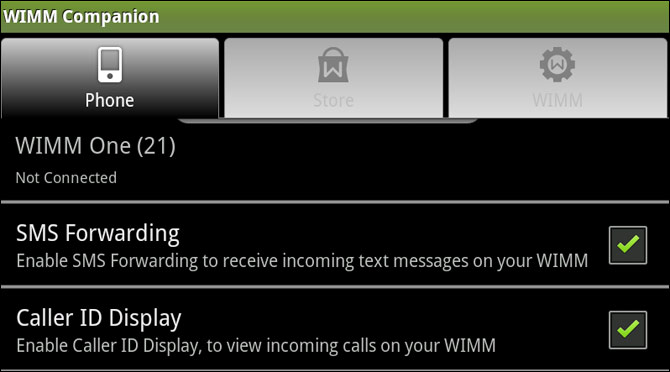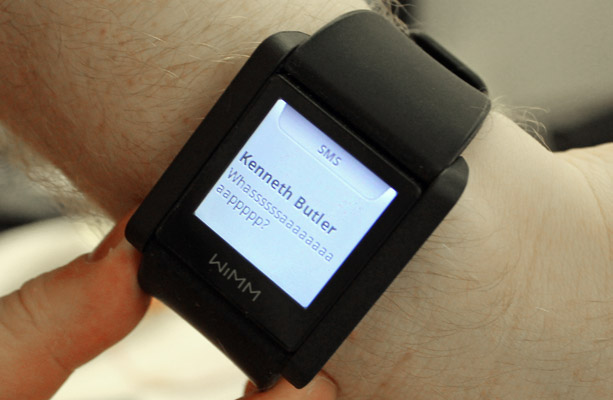WIMM One Android Watch Tested: Groundbreaking Wrist Computer Delivers
The world has been waiting for a Dick Tracy-like computer watch for decades, but up until now, nothing has even come close to providing a full-fledged computing experience in a wrist-friendly design. Enter the WIMM One, the world's first Android watch. Available as a $299 preview device for developers, the WIMM One is capable of running a host of custom apps, syncing with your phone, and pulling in the latest news headlines from the web using its Wi-Fi connection. We've been wearing this gadget as our everyday timepiece for three weeks now, and we're blown away by its potential.
Design
The developer kit comes with the module itself, a simple black wristband, and a charging kit. The 1.4 x 1.3 x .5-inch WIMM One module, which comes detached from the wristband, is no larger or heavier than many of today's plain digital watches. The front of the module has a 1.4-inch touchscreen, surrounded by a shiny black bezel, the bottom of which contains the WIMM logo, though we suspect the branding would change as this is licensed to partners.
The right side of the module houses its only button, a tiny power button that you should never need to use, except for the first time you turn it on or if there's a need to emergency reset the device, something we never needed to do in three weeks of constant use. The back of the module has 14 metal teeth that connect to corresponding pins on the charging dock.
The device snaps into the tiny dock and stays in place through the use of magnets. When docked, the module can plug into either the wall or a PC's USB port for charging. When attached to a PC, you can mount the device to copy files back and forth from the non-removable 2GB microSD card.
The module pops into the wrsistband securely by pushing it up through the bottom of the band's mount. Once seated in the band, the module remains securely in place, even if you wave the watch around. Perhaps to underscore that you never need the power button after the first setup, the band's mount covers it.
Though it won't win a fashion contest, the WIMM One looks pretty good on the wrist, reminding us of a typical digital watch from the likes of Casio or Armitron. However, we look forward to seeing the types of bands that come with the device when it's released commercially.
Sign up to receive The Snapshot, a free special dispatch from Laptop Mag, in your inbox.
The WIMM Vision
With a universe full of powerful mobile devices with established uses, the WIMM One isn't trying to compete with your notebook, tablet, or smartphone. WIMM Labs, the company behind the watch, sees wearable devices like watches enabling a whole new world of what it calls microexperiences.
Vice president of product marketing Tim Twerdahl told us that the company sees an inverse relationship between the size of a device and the length of usage sessions, with users spending hours in a row on larger-screened devices such as notebooks and tablets, but only picking them up a few times a day versus dozens of times a day for minutes at a time on smaller devices like your smartphone. The WIMM One, its creators posit, is best when used scores of times a day for a very short period of time. These microexperiences could be as short as glancing at the watch face to check the temperature or tapping through to a home automation app to turn the lights off in your house.
While we see the merit in designing for short bursts of interactivity, we can also see the potential for longer sessions that don't necessarily fall into the microexperiences category. Imagine playing a game, reading the news, or scrolling through an inbox for several minutes at a time.
WIMM Labs has no plans to market its product directly to the public. Instead, the company intends to build a strong hardware and software platform it can license to other companies who will then package and sell the device under their own brands.
Though WIMM hasn't announced any partnerships yet, Twerdahl told us to expect a number of different partners to sell the WIMM One in 2012. Depending on what accessories and apps it comes with, the device could be sold as a sports watch that helps you keep track of workouts, as a pendant or belt accessory that that gives you quick information at a glance, or as a social-media key fob that attaches to your luggage and helps you check in wherever you go.
We prefer the most obvious use of the WIMM One, as a supercharged wrist companion that's capable of doing lots of things well. Through its partnership with leading Chinese manufacturer Foxconn, WIMM says its capable of ramping up production to meet virtually any partner's demands.
Twerdahl told us that, no matter how the WIMM One is sold, the first generation of units will likely carry the same specs and design from partner to partner, with the size of the internal microSD card ranging from 2 to 32GB. He said the company is capable of tweaking things like the screen, casing, or internal components for a partner, but that most partners they've spoken to are happy with the reference design and want to create a custom experience with pre-loaded apps and accessories like the band.
We don't know how WIMM's partners will price their versions of the WIMM One, but Twerdahl told us not to expect them to be significantly less expensive than the $299 developer kit model. Considering all the small components involved, he said that mass production will not significantly cut costs. Though we've recently seen Android tablets like the Kindle Fire and Lenovo IdeaPad A1 priced at under $200, these devices don't require the same level of miniaturization as a watch.
Specs
The WIMM One looks pretty good on the inside, with a 667-MHz ATM 11 processor, Wi-Fi radio, Bluetooth, an accelerometer, 256MB of mDDR memory, 128MB of DRAM, and 512MB of internal flash. A second controller manages the watch face and accelerometer when everything else is asleep. The device has a 2GB, non-removable microSD card built in for storing data, though partners who offer the watch can include a larger card that's up to 32GB capacity. The module also has a GPS radio inside, though it is currently disabled by software.
Unfortunately, the WIMM One doesn't have the ability to play sounds other than a straightforward beep for the alarm. A haptic feedback unit allows the watch to vibrate during alerts as well. The WIMM One also lacks a microphone or camera so forget about using it to video chat a la Dick Tracey.
There's no headphone jack for enabling audio out, though WIMM told us that it is working on a Bluetooth profile that will allow the watch to pair with Bluetooth-enabled headphones for playback. Nobody has made a video playback app yet, but we're pretty certain the device could handle low-resolution video.
Screen
The 1.4-inch, 160 x 160 resolution dual-mode screen is the WIMM One's most intriguing feature. When you're not interacting with the device, the screen goes into grayscale mode, putting itself into a low-power state and showing only the watch face, which looks like a typical grayscale digital watch. However, the moment you touch the face, the watch goes into Android mode, allowing you to see up to 65,000 colors on its vibrant capacitive touch screen.
Set Up
When you first take the device out of the box and power it on, the software requires that you connect it to a Wi-Fi hotspot. Since the WIMM One doesn't have a virtual keyboard of any kind, it offers a scrolling list of letters and characters and you must scroll through to select one at time in order to enter the correct password for your router.
Once, you've connected the Internet for the first time, the watch syncs to WIMM's servers and provides you with an activation code. You must register for a free developer account at WIMM.com and enter the activation code from the watch there so the account is connected to your phone. With the account synced, you can then control a number of settings from WIMM's web-based interface, including the date and time format, home location, weather and world clock cities, and calendar accounts to sync.
Considering that WIMM's business model is based on licensing its watch to third parties, we expect the online set up portal to look a bit different when partners sell the watch under their own brands. The WIMM logo and branding won't be there and the options and registration process may be a bit different as well.
User Interface
Though the WIMM One's operating system is a form of Android, the custom UI is designed for a tiny 160 x 160 screen and therefore looks nothing like any version of Android we've ever seen. There's no status bar, no back/home/ menu buttons, and no apps menu filled with lots of tiny shortcut icons. Every button and icon is large and finger-friendly.
When the user isn't actively interacting with the device, it simply shows the current watch face, which displays information like the time, date, and possibly the weather. Tapping on the watch face wakes the watch up and turns the watch face to full color. At that point, you can long press to see a list of available watch faces, swipe down to view the amount of battery remaining, or swipe upward to return to either whatever app you were using before or the app menu (if you didn't have a specific app open before the device last went into watch mode).
The app menu is a 3D carousel that shows large icons for each of your open apps, with only one icon and a side view of two others visible at any one time. Tapping on a shortcut icon launches its associated app. When you're in an app or the apps menu, swiping down from the top takes you back a screen, which could bring you to a higher-level menu in the app, back to the apps menu, or all the way back to the watch face.
Unfortunately, the WIMM One has a 15-second timeout no matter what you are doing. That means that whether you are trying to look at the weather or read news stories in the newsfeed app, you better touch the screen frequently or risk having the screen turn grayscale and return to its watch face, the equivalent of an Android phone timing out and returning to its lock screen. Whatever app you're in will turn grayscale two seconds before returning to the face. We hope WIMM will allow users to change the timeout time in a future update, but for now, it remains way too short.
Within apps, swiping up scrolls down the screen and swiping left or right often takes you back and forth to other screens on the same level. Many apps, such as the settings menu, also have menu buttons that take you into sub-menu pages. A number of settings, both in apps and the main settings menu, have on/off toggle switches.
Don't expect to be doing a lot of data input on any app, as the WIMM One does not have a virtual keyboard. The few apps that require any kind of text entry (e.g., Wi-Fi passwords) launch a scrolling list of letters and characters. To enter each character, you must scroll through the entire list to tap and then scroll around again to find the next character.
Settings and Sync
Using the built-in settings menu, you can toggle the Wi-Fi, Bluetooth, and location services while also selecting from a list of available wireless networks. You can also control the beep volume, whether or not the watch vibrates on alert, set the brightness level, or toggle USB debugging from the settings menu.
WIMM's web-based interface lets you control some of the same settings via your browser and also allows a few additional options not available on the watch itself. Using the web interface, you can decide which watch faces to show on the watch face menu, what cities appear on the world clock app, and which of the built-in apps to show in the apps menu. More importantly, you can add/remove Google or Exchange calendar accounts to sync with the watch's calendar.
The WIMM One syncs to WIMM's servers on a regular basis, and the settings allow you to configure a frequency between 1 and 24 hours per sync. At each sync, the watch downloads any changes to your calendar events, any settings you may have changed via the web interface, and any content third-party apps like the newsreader require to stay fresh. If you can't wait until the next scheduled sync, you can tap a button in the settings menu to sync manually.
Twerdahl explained to us that the WIMM One puts its Wi-Fi connection to sleep between syncs in order to preserve juice. However, he said that the company is considering changing the options so users can schedule more frequent syncs, perhaps as often as every 10 or 15 minutes.
Watch Faces
To switch faces, simply long-press the middle of the current face and wait for a set of thumbnails to appear. You can scroll right or left to choose the face you want. Watch faces appear colorful for a few seconds after you tap them, but change into grayscale mode to save juice. You can also control which faces are available from the menu by using the web-based control panel on wimm.com to select or deselect them.
Users can choose between a number of watch faces with different looks, ranging from an analog clock to a simple digital time display. You can also install third-party watch faces from developers; WIMM expects its Micro App Store to be filled with different faces once it launches.
Our favorite face so far is The Fahrenheit, which combines a simple digital readout of the time and date with the current high and low temperature in your area. We can't overestimate the number of times we decided whether or not to wear a coat based on a quick glance at our wrist.
Faces like the Valencia, the Zurich, and the Shadow simulate the look of an analog watch. The Globetrotter shows a few world times, while the Mod and the Swinger both show garish displays of just the time. The Closer shows the time against a Windows XP-like green grass background and the Gambler makes the time look like a slot machine. We're hoping someone will come out with a watch face that displays email messages or news articles in the future.
Calendar
If you use the web interface to set up the calendar function, it will update the current list of appointments on the watch at every sync. In the watch's calendar app, you can scroll through a list of appointments on each day, tapping on each appointment to see details like the location and notes that have been pulled down from Exchange or Google Calendar. You can also move between days by swiping left (back a day) or right (forward a day). A little calendar icon in the upper-right corner lets you see a layout of the entire month, but it is rather useless because you cannot tap on individual days to view them.
On each day's view, you'll see appointments not only from all of your calendars, but also from any calendars that others have shared with your accounts. Unfortunately, this means that our 10 a.m. meeting was right next to the 10 a.m. meetings of two coworkers, which was a little confusing. We wish there was a way to set the calendar not to show others' appointments.
When you have an appointment of your own scheduled, the watch will alert you 15 minutes beforehand by showing the details on the main screen instead of your watch face (or whatever else you are doing at the moment) and vibrating. During our testing, we found ourselves relying heavily on these alerts.
Micro App Store
In addition to building the hardware and developing the watch's custom version of Android, WIMM will maintain the Micro App Store, which will house a bevvy of custom watch-friendly apps built by third-party developers. WIMM's partners will be able to customize the app store for their products so only the types of apps they want to show customers will appear in their versions of the store. For example, a sports watch maker might not want games or social-media apps appearing in its version of the Micro App Store.
The Micro App store isn't live yet, but if you hang out in WIMM's developer forums, you'll see a number of programmers posting beta or alpha versions of their micro apps. Sideloading these apps is as simple as downloading their APK files from the forum and then dragging them into the root folder of the watch's internal memory. Once an APK file is there, the watch automatically installs it and adds it to the app menu.
Micro Apps
The WIMM One developer kit comes with six built-in micro apps, though we expect the selection of preloaded apps will grow significantly when partners release the watch under their own brands. The built-in micro apps include the calendar, a world clock that shows the time in different cities you set, an alarm app, a stopwatch, and a timer. The most useful of these apps are the calendar and the weather app, which lets you see a 7-day forecast for your home location and any additional cities you designate.
Though the micro app store isn't up yet, we were able to download some beta and alpha level apps from the WIMM developer forums and sideload them to the device. Our favorite of these third-party apps is the micro newsreader, which downloads stories from RSS feeds, either by using your Google Reader account or by using a list of popular news feeds that are built into the program. At each sync, the newsreader downloads fresh content from all of your RSS feeds then displays a list of the latest headlines from each site.
In the newsreader, you move from site to site—for example, from Engadget headlines to BGR headlines—by swiping right or left. On each site's screen is a list of headlines you can scroll through, opening the stories that interest you by tapping on their headlines. When viewing a story, there's a full color photo underneath the headline and the article text is below. Unfortunately, during our testing, the reader did not support formatting. As a result, all paragraphs of a story were jammed together into one text block, and there were no inline images, links, or videos. The 15-second timeout is a bigger hindrance than the lack of formatting support, because the watch would return to the home screen while we were trying to read a story.
Balance Ball, a game that lets you roll a ball around a board using the watch's accelerometer, is an interesting proof of concept. Micro Maps lets you pan around the globe, but isn't all that useful at this point. The Simple Calculator allows you to do simple math. SportyPal lets you count how many calories you might burn at the gym. Unified Remote is supposed to allow you to control your PC from the watch by installing some software on your Windows PC, but it didn't work for us. Astrid Tasks syncs to an online to-do list, but that also didn't work for us.
At present, there are a few glaring omissions from both the built-in and beta app selection. There's no email software, no contacts app, no social-networking software, no way to view instant messages, no photo gallery, no web browser, and no media player. Considering the lack of a persistent Internet connection, we're not sure if there will be a full web browser or real-time IMs, but we'd like to have the ability to access more content both on and offline.
Performance
The current build of the operating system suffers from some sluggishness, which WIMM is working to fix. In our testing, we often had to tap or swipe a second or third time to have our inputs register. Scrolling down a screen or swiping between screens was often jerky. However, the operating system and apps were rock solid; we never once experienced a crash or lockup. WIMM told us it is already testing a software update that will significantly improve performance.
Phone Syncing
By installing a simple app on your Android or BlackBerry phone, you can tether the watch to your handset in order to see incoming calls or SMS messages from your phone in real-time. We installed the Android WIMM companion on a Samsung Stratosphere 4G phone, and were able to easily pair our handset with the watch.
When the companion software was running and Bluetooth was enabled on both devices, we were able to see caller IDs from incoming calls, even while the phone was in our pocket. A button on the phone screen allowed us to send these calls directly to voicemail if we wished to avoid pulling the phone out of our pocket. SMS messages also appeared on-screen as soon as we received them, though there's no way to respond to them.
When you consider how long it can take to fumble through a jacket or purse to pull out a ringing phone, knowing who is calling or texting you can be a big time saver. If the caller or message doesn't require your immediate attention, you don't need to whip out your phone. At one point we were in a dentist's chair, but were able to read a text message on the watch face and then determine that it was important enough to merit taking out our phone for an immediate response.
Unfortunately, once you've swiped away from a message on the WIMM One, that message does not remain archived anywhere on the watch. You'll have to pick up your phone to see a list of your old SMS messages and missed calls. You also can't get other information from your phone just yet. We'd love to see Google Talk or other instant messenger messages displayed on the watch and we'd also like to get our phone's contacts onto the watch in some way. WIMM tells us it is opening this Bluetooth connection up to third-party developers.
Battery Life
With Wi-Fi on, brightness set to low, and the module set to sync once per hour, the WIMM One typically lasted 10 to 11 hours on charge, with the occasional watch tap throughout the day to read news from the newsreader or check the weather. With Bluetooth on and the watch paired with our Samsung Stratosphere phone, both the phone and the watch lasted only 7 to 8 hours of light use. WIMM told us that battery life in Bluetooth mode depends a lot on the phone's individual Bluetooth radio, so your results may vary.
Though it doesn't last as long as we'd like on a charge, the WIMM One juices up in a hurry. Our module was usually fully charged after less than an hour on the charger. It also charges quite effectively when plugged into a USB port.
Future Improvements
The WIMM One is still in developer preview mode, so we can expect a number of improvements in the weeks and months to come, particularly after partners begin selling their own branded versions of the device. Among the improvements we expect to see are:
- Improved Performance: An upcoming software update should make the device more responsive.
- Micro App Store: WIMM will soon have a store up with a wide array of vetted apps.
- Email: Whether from WIMM Labs or a third-party developer, we expect to see an app that will allow users to see their incoming messages.
- Enhanced Bluetooth Support: Right now, the WIMM One can only pair with an Android or BlackBerry smartphone and only send SMS and caller ID info to the watch. WIMM is updating its Bluetooth support so it can pair with headphones or Bluetooth peripherals such as an external keyboard.
- Improved Phone Functionality: Developers will be able to write apps either on the phone side or the WIMM side that exchange more data than just SMS and incoming calls between the handset and the watch. Imagine incoming Google Talk, Skype, or BBM messages appearing on the watch as soon as the phone receives them.
- Social Media Integration: There will be some way to view FaceBook, Twitter, and other social network updates on the watch.
- More Frequent Syncs: You will likely be able to increase the sync time to once every 10 or 15 minutes.
- GPS Support: The onboard GPS radio will be enabled and empower developers to build all kinds of location-based apps.
Early Verdict
The WIMM One is truly the first of its kind, a real Android computer for your wrist. In the past we've seen watches like the Sony LiveView, which are nothing more than dumb terminals that tether to your phone, and we've seen high-tech sports watches like the MotoaACTV, but we've never seen a wearable device that promises an entire ecosystem of apps filled with endless possibilities. In its present state, the device is still a bit rough around the edges, but useful enough to wear every day. We can't wait to see what developers and partners due with this promising platform.


